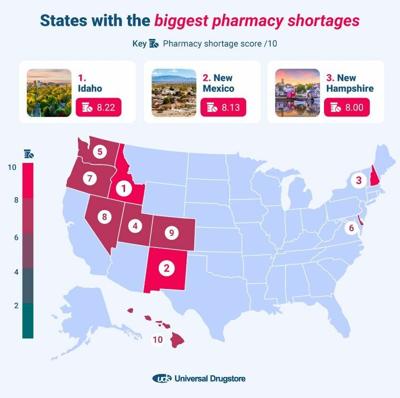New Mexico has the second-highest pharmacy shortage in the U.S., according to research recently published by Universal Drugstore, which analyzed a range of factors, from the number of pharmacists per population to notable drug store closures.
In the nation's healthcare system, local pharmacies play a crucial role in serving communities. Yet, the recent Universal Drugstore study revealed a worrying trend, particularly in New Mexico: a drop in pharmacy access and pharmacy jobs.
The research found that, on average, there are just 11 CVS drugstores in the state per one million people, meaning residents in New Mexico would find it more difficult than average to access their prescriptions. Moreover, the small number pharmacies operating across the state saw a large -8.56 percent decline in jobs from 2021–22, the fifth-highest decline in the nation.
On the list of states with the least pharmacists, New Mexico ranked 10th, with 86 pharmacists per 100,00 people. The state is home to just one pharmacy school — the UNM College of Pharmacy in Albuquerque, a relatively small program with an average of 15 students — meaning New Mexico ranks fourth-lowest in the national for access to pharmacy schools.
According to data published in 2022 in the Journal of the American Pharmacies Association, 45 percent of New Mexico counties are considered "pharmacy scarce," with less than 1.38 pharmacies per 10,000 residents. The research also found the majority of the nation's population lived within 10 miles of a pharmacy, though this access differed greatly between urban and rural areas.
With a population of 34,000 residents and six pharmacies, Taos County ranks higher than the state average for pharmacy access, with 1.76 per 10,000 residents. Pharmacies are available Holy Cross Medical Center, Taos-Picuris Indian Health Center, Walgreens, Walmart, Albertsons, and Smith's. All are located in Taos, with the Indian Health Services located at Taos Pueblo — meaning rural residents in Questa, Costilla or Red River may have to drive up to 50 miles to access a pharmacy, a distance significantly greater than the national average.
Pharmacy access in the state is shown to be decreasing over time. In research published in Becker's Hospital Review in 2021, New Mexico had the ninth-highest pharmacy shortage in the U.S. at 1.84 pharmacies per 10,000 residents. Now, the state is home to second-highest pharmacy shortage in the nation.
As pharmacy access becomes more limited, residents will find it increasingly difficult to access prescription and over-the-counter medications.
An August 2023 briefing at the state Legislature on rural healthcare access in New Mexico found travel distances, aging populations, lack of providers, higher poverty rates, and reduced hospital services to be some of the main challenges to improving healthcare outcomes for the more than one-fifth of New Mexicans who live in rural communities.
"Because of these challenges and others, rural communities experience greater health disparities, such as higher mortality rates, lower life expectancies, high rates of chronic disease, poor maternal and child health outcomes, more substance abuse, and higher rates of chronic pain. Rural residents also have limited job opportunities and are less likely to have employer-provided health insurance," the brief said.













(0) comments
Welcome to the discussion.
Log In
All comment authors MUST use their real names. Posts that cannot be ascribed to a real person
will not be moderated.
Keep it Clean. Please avoid obscene, vulgar, lewd, racist or sexually-oriented language.
PLEASE TURN OFF YOUR CAPS LOCK.
Don't Threaten. Threats of harming another person will not be tolerated.
Be Truthful. Don't knowingly lie about anyone or anything.
Be Nice. No racism, sexism or any sort of -ism that is degrading to another person.
Be Proactive. Use the 'Report' link on each comment to let us know of abusive posts.
Share with Us. We'd love to hear eyewitness accounts, the history behind an article.